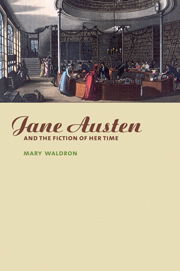Book contents
- Frontmatter
- Contents
- Acknowledgements
- Texts and abbreviations
- Introduction
- 1 The juvenilia, the early unfinished novels and Northanger Abbey
- 2 The non-heiresses: The Watsons and Pride and Prejudice
- 3 Sense and the single girl
- 4 The frailties of Fanny
- 5 Men of sense and silly wives – the confusions of Mr Knightley
- 6 Rationality and rebellion: Persuasion and the model girl
- 7 Sanditon – conclusion
- Notes
- Bibliography
- Index
2 - The non-heiresses: The Watsons and Pride and Prejudice
Published online by Cambridge University Press: 22 September 2009
- Frontmatter
- Contents
- Acknowledgements
- Texts and abbreviations
- Introduction
- 1 The juvenilia, the early unfinished novels and Northanger Abbey
- 2 The non-heiresses: The Watsons and Pride and Prejudice
- 3 Sense and the single girl
- 4 The frailties of Fanny
- 5 Men of sense and silly wives – the confusions of Mr Knightley
- 6 Rationality and rebellion: Persuasion and the model girl
- 7 Sanditon – conclusion
- Notes
- Bibliography
- Index
Summary
Jane Austen's continuous consciousness of the fictional tradition within which she worked has frequently been discussed by scholars and critics. In Pride and Prejudice there is a strong structural and thematic connection with the novels of Fanny Burney, especially with Cecilia (1782), but also with Camilla, published in 1796 when Austen was reportedly engaged with the first draft of the novel, entitled ‘First Impressions’. My own analysis of the interaction between Burney and Austen between 1796 and the final publication of Pride and Prejudice differs somewhat from that of others, as will become evident in what follows. Too often the search for a consistent set of moral objectives has led critics to conclude that Austen has failed in her attempts to subvert Burney, suggesting, as Marilyn Butler has done, that she has ‘badly fudged the moral issue’ and left the reader in a ‘moral limbo’. ‘Confusion enters’, she writes, ‘because as a whole intelligence is represented as faulty in the novel.’ Examining Pride and Prejudice's probable genesis and some of its crucial episodes will strongly suggest that the ‘confusion’ is intended, and is itself part of the challenge to Austen's contemporaries.
In contrast to the novels of sensibility in the Mackenzie manner, Fanny Burney's fiction seems almost obsessively concerned with money.
- Type
- Chapter
- Information
- Jane Austen and the Fiction of her Time , pp. 37 - 61Publisher: Cambridge University PressPrint publication year: 1999



